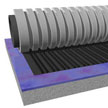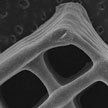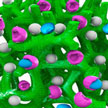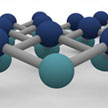Showing Spotlights 1065 - 1072 of 2786 in category All (newest first):
 In an effort to find a way to introduce folds or waves into graphene in a simple and large-scale way, researchers have invented a rubber-stamp printing method to introduce waves into the graphene. The ability to controllably form folds in graphene has significant research and technological applications. Induced folds have a sublithographic width and macroscopic length. They could be used as channel materials or interconnects in chips, and it has been shown that stable field emitters are formed by folded graphene.
In an effort to find a way to introduce folds or waves into graphene in a simple and large-scale way, researchers have invented a rubber-stamp printing method to introduce waves into the graphene. The ability to controllably form folds in graphene has significant research and technological applications. Induced folds have a sublithographic width and macroscopic length. They could be used as channel materials or interconnects in chips, and it has been shown that stable field emitters are formed by folded graphene.
Feb 16th, 2015
 The successful implementation of graphene-based devices invariably requires the precise patterning of graphene sheets at both the micrometer and nanometer scale. It appears that 3D-printing techniques are an attractive fabrication route towards three-dimensional graphene structures. Researchers have now used flakes of chemically modified graphene, namely graphene oxide GO and its reduced form rGO, together with very small amounts of a responsive polymer, to formulate water based ink or pastes to be used in 3D printers.
The successful implementation of graphene-based devices invariably requires the precise patterning of graphene sheets at both the micrometer and nanometer scale. It appears that 3D-printing techniques are an attractive fabrication route towards three-dimensional graphene structures. Researchers have now used flakes of chemically modified graphene, namely graphene oxide GO and its reduced form rGO, together with very small amounts of a responsive polymer, to formulate water based ink or pastes to be used in 3D printers.
Feb 9th, 2015
 This article briefly describes how nanomaterials and nanotechnology can be useful in the strategic area of camouflage and stealth technology. The section on threat perception briefly describes about various sensors and platforms from where those sensors can be operated for the purpose of surveillance, detection and identification of military objects. Prominent nanomaterials, which can find applications in futuristic stealth have been discussed.
This article briefly describes how nanomaterials and nanotechnology can be useful in the strategic area of camouflage and stealth technology. The section on threat perception briefly describes about various sensors and platforms from where those sensors can be operated for the purpose of surveillance, detection and identification of military objects. Prominent nanomaterials, which can find applications in futuristic stealth have been discussed.
Jan 30th, 2015
 Designing systems that build themselves is one of the great dreams of nanotechnology researchers, and they are taking great strides towards developing such 'bottom-up' nanotechnology fabrication techniques. Fabrication processes based on DNA might change this: DNA origami have been heralded as a potential breakthrough for the creation of nanoscale devices. Researchers have now developed methods to assemble DNA-functionalized microparticles into a colloidal gel, and to extrude this gel with a 3D printer at centimeter size scales.
Designing systems that build themselves is one of the great dreams of nanotechnology researchers, and they are taking great strides towards developing such 'bottom-up' nanotechnology fabrication techniques. Fabrication processes based on DNA might change this: DNA origami have been heralded as a potential breakthrough for the creation of nanoscale devices. Researchers have now developed methods to assemble DNA-functionalized microparticles into a colloidal gel, and to extrude this gel with a 3D printer at centimeter size scales.
Jan 29th, 2015
 At the end of their product life cycle, nanomaterials can enter waste treat ment plants and landfills via diverse waste streams. Little, however, is known about how nanomaterials behave in the disposal phase and whether potential environmental or health risks arise. The current assumption is that stable nanoparticles are neither chemically nor physically altered in waste incineration plants and that they accumulate especially in the residues (e.g. slag). These residues are ultimately dumped. The disposal problem in the case of stable nanoparticles is therefore merely shifted to the subsequent steps in the waste treatment process.
At the end of their product life cycle, nanomaterials can enter waste treat ment plants and landfills via diverse waste streams. Little, however, is known about how nanomaterials behave in the disposal phase and whether potential environmental or health risks arise. The current assumption is that stable nanoparticles are neither chemically nor physically altered in waste incineration plants and that they accumulate especially in the residues (e.g. slag). These residues are ultimately dumped. The disposal problem in the case of stable nanoparticles is therefore merely shifted to the subsequent steps in the waste treatment process.
Jan 27th, 2015
 Researchers have successfully built rollable and transparent electronic devices that are not only lightweight, but also don't break easily. They managed to overcome two major challenges associated with the manufacture of flexible electronics: The temperature restriction of plastic substrates and the difficulty of handling flexible electronics during the fabrication process. The team rolled their transistor devices 100 times on a cylinder with radius of 4 mm, without significantly degrading their performance.
Researchers have successfully built rollable and transparent electronic devices that are not only lightweight, but also don't break easily. They managed to overcome two major challenges associated with the manufacture of flexible electronics: The temperature restriction of plastic substrates and the difficulty of handling flexible electronics during the fabrication process. The team rolled their transistor devices 100 times on a cylinder with radius of 4 mm, without significantly degrading their performance.
Jan 23rd, 2015
 So far, there have been very few research reports on single electrode materials that enable the simultaneous detection of different metabolites - such as glucose, urea, cholesterol, and triglycerides - in whole blood. Moreover, it is a considerable challenge to integrate all required materials and devices on a single chip to ultimately produce a multiplexing biosensor array. In new work, researchers demonstrate that biosensors based on conducting polymer hydrogels enable the precise and full-range detection of different metabolites in human blood.
So far, there have been very few research reports on single electrode materials that enable the simultaneous detection of different metabolites - such as glucose, urea, cholesterol, and triglycerides - in whole blood. Moreover, it is a considerable challenge to integrate all required materials and devices on a single chip to ultimately produce a multiplexing biosensor array. In new work, researchers demonstrate that biosensors based on conducting polymer hydrogels enable the precise and full-range detection of different metabolites in human blood.
Jan 22nd, 2015
 A comprehensive analysis of the fundamental properties, synthesis approaches and the future prospects of silicene, germanene, stanene, and phosphorene. It covers the literature on the fundamental properties of graphene analogous elemental sheets, inclusive of both theoretical and experimental knowledge. Various bottom-up synthesis techniques and top-down exfoliation approaches for the fabrication of two-dimensional elemental sheets are discussed.
A comprehensive analysis of the fundamental properties, synthesis approaches and the future prospects of silicene, germanene, stanene, and phosphorene. It covers the literature on the fundamental properties of graphene analogous elemental sheets, inclusive of both theoretical and experimental knowledge. Various bottom-up synthesis techniques and top-down exfoliation approaches for the fabrication of two-dimensional elemental sheets are discussed.
Jan 21st, 2015
 In an effort to find a way to introduce folds or waves into graphene in a simple and large-scale way, researchers have invented a rubber-stamp printing method to introduce waves into the graphene. The ability to controllably form folds in graphene has significant research and technological applications. Induced folds have a sublithographic width and macroscopic length. They could be used as channel materials or interconnects in chips, and it has been shown that stable field emitters are formed by folded graphene.
In an effort to find a way to introduce folds or waves into graphene in a simple and large-scale way, researchers have invented a rubber-stamp printing method to introduce waves into the graphene. The ability to controllably form folds in graphene has significant research and technological applications. Induced folds have a sublithographic width and macroscopic length. They could be used as channel materials or interconnects in chips, and it has been shown that stable field emitters are formed by folded graphene.
 Subscribe to our Nanotechnology Spotlight feed
Subscribe to our Nanotechnology Spotlight feed





